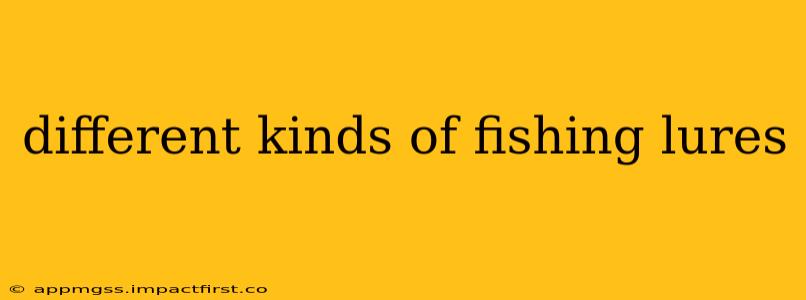Fishing lures are artificial bait designed to entice fish into biting. With countless options available, choosing the right lure can significantly impact your success. This guide explores the diverse world of fishing lures, categorized by type and design, helping you select the perfect lure for your next fishing adventure.
What are the Main Types of Fishing Lures?
Fishing lures are broadly categorized into several main types, each with its own unique action, appeal, and target species. These categories often overlap, as some lures blend characteristics from multiple types.
1. Spoons: Classic Simplicity and Effective Action
Spoons are among the oldest and most reliable fishing lures. Their simple, spoon-shaped design creates a shimmering, enticing flash underwater. They are often retrieved with a combination of fast and slow retrieves, creating a wavering, enticing action that attracts fish. Different spoon sizes and weights target various fish species and water depths.
2. Spinnerbaits: Blades and Buzz
Spinnerbaits feature a rotating blade that generates vibrations and flashes, attracting fish from a distance. The blade's rotation creates a commotion in the water, irresistible to many predatory fish. They are highly effective in both shallow and deeper waters, depending on the weight and design. Adding a trailer, such as a plastic worm or grub, enhances their appeal.
3. Crankbaits: Diving Deep and Shallow
Crankbaits are designed to dive to specific depths, making them versatile for targeting fish at various levels in the water column. Their design, lip shape, and weight determine their diving depth. Shallow crankbaits work well near the surface, while deep-diving crankbaits can reach significant depths. The erratic movements of a crankbait on retrieve can provoke strikes.
4. Topwater Lures: Surface Action and Explosions
Topwater lures are designed to sit on the surface of the water, creating enticing disturbances and splashes. These lures, including poppers, buzzbaits, and walkers, trigger aggressive strikes from surface-feeding fish. Their action can be erratic and noisy, mimicking injured or fleeing prey.
5. Jigs: Versatility and Weighted Appeal
Jigs are weighted lures typically featuring a hook and a soft plastic or lead head. Their versatility is immense, as different jig designs (such as Texas rigs, Carolina rigs, and shaky heads) and trailer combinations can target various species and fishing conditions. The weighted head allows for deep diving, while the soft plastic trailer adds action and allure.
6. Soft Plastic Lures: Lifelike Movement and Flexibility
Soft plastic lures, including worms, grubs, and creature baits, mimic natural prey, offering a lifelike appearance and enticing action. They can be rigged on various hooks and weights, adapting to different fishing situations. Their flexibility and lifelike movement trigger strikes from a wide range of fish.
What are the Different Types of Fishing Lure Actions?
The action of a lure refers to how it moves in the water. This is a crucial factor in attracting fish.
1. Floating Lures: Staying Afloat
Floating lures remain near the surface, making them ideal for topwater fishing. These lures need to be reeled consistently.
2. Suspending Lures: Pausing in the Water Column
Suspending lures pause in the water column after retrieval stops, mimicking an injured or resting prey. This pause can trigger strikes from ambush predators.
3. Sinking Lures: Diving to Depth
Sinking lures descend to specific depths, allowing you to target fish at various levels in the water column.
What are the Best Fishing Lures for Beginners?
For beginners, simple and versatile lures are recommended:
- Spinnerbaits: Easy to use and effective across various conditions.
- Crankbaits: A good choice for targeting fish at different depths.
- Soft plastic worms: Simple to rig and highly effective for many species.
What are some other important factors to consider when choosing a fishing lure?
Beyond the basic types, several factors influence lure selection:
- Water clarity: Clear water necessitates more subtle lures, while murky water allows for louder, more vibrant choices.
- Water depth: Different lures are designed for specific depths.
- Target species: Certain lures are more effective for particular fish species.
- Retrieve: The way you retrieve the lure significantly affects its action.
- Color: Lure color selection varies depending on water conditions and fish preference.
By understanding the diverse world of fishing lures and their characteristics, you can significantly enhance your angling success. Remember, experimentation is key—try different lures and techniques to discover what works best for you and your target species.
